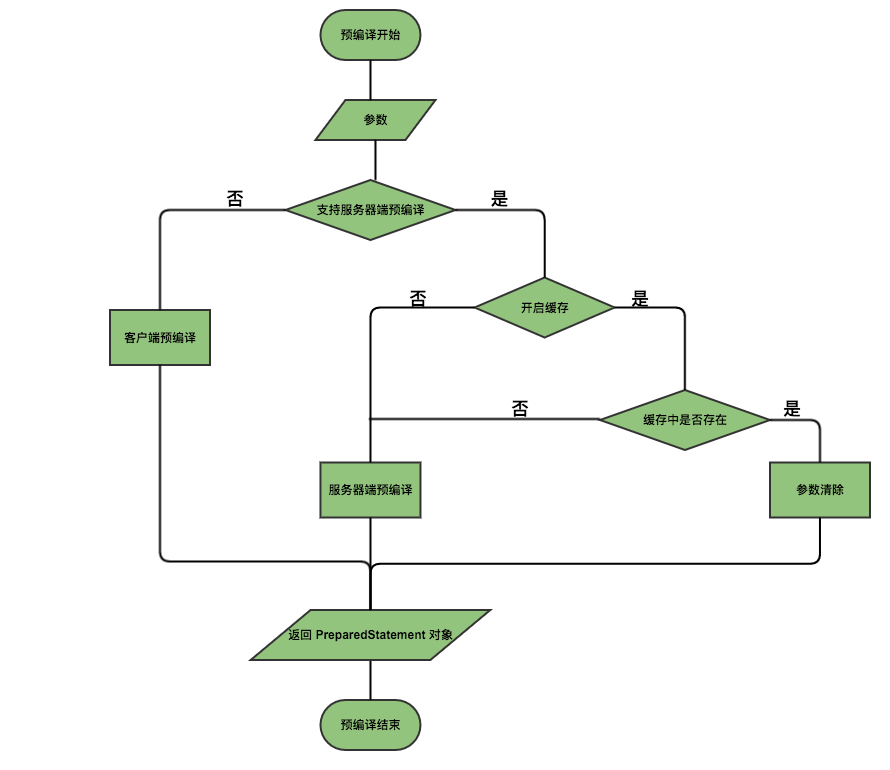mybatis 中使用 sqlMap 进行 sql 查询时,经常需要动态传递参数,例如我们需要根据用户的姓名来筛选用户时,sql 如下:
select * from user where name = "ruhua";上述 sql 中,我们希望 name 后的参数 "ruhua" 是动态可变的,即不同的时刻根据不同的姓名来查询用户。在 sqlMap 的 xml 文件中使用如下的 sql 可以实现动态传递参数 name:
select * from user where name = #{name};
或者
select * from user where name = '${name}';
对于上述这种查询情况来说,使用 #{ } 和 ${ } 的结果是相同的,但是在某些情况下,我们只能使用二者其一。
'#' 与 '$'
区别
动态 SQL 是 mybatis 的强大特性之一,也是它优于其他 ORM 框架的一个重要原因。mybatis 在对 sql 语句进行预编译之前,会对 sql 进行动态解析,解析为一个 BoundSql 对象,也是在此处对动态 SQL 进行处理的。
在动态 SQL 解析阶段, #{ } 和 ${ } 会有不同的表现:
#{ } 解析为一个 JDBC 预编译语句(prepared statement)的参数标记符。
例如,sqlMap 中如下的 sql 语句
select * from user where name = #{name};解析为:
select * from user where name = ?;一个 #{ } 被解析为一个参数占位符 ? 。
而,
${ } 仅仅为一个纯碎的 string 替换,在动态 SQL 解析阶段将会进行变量替换
例如,sqlMap 中如下的 sql
select * from user where name = '${name}';当我们传递的参数为 "ruhua" 时,上述 sql 的解析为:
select * from user where name = "ruhua";预编译之前的 SQL 语句已经不包含变量 name 了。
综上所得, ${ } 的变量的替换阶段是在动态 SQL 解析阶段,而 #{ }的变量的替换是在 DBMS 中。
用法 tips
1、能使用 #{ } 的地方就用 #{ }
首先这是为了性能考虑的,相同的预编译 sql 可以重复利用。
其次,${ } 在预编译之前已经被变量替换了,这会存在 sql 注入问题。例如,如下的 sql,
select * from ${tableName} where name = #{name} 假如,我们的参数 tableName 为 user; delete user; --,那么 SQL 动态解析阶段之后,预编译之前的 sql 将变为
select * from user; delete user; -- where name = ?;-- 之后的语句将作为注释,不起作用,因此本来的一条查询语句偷偷的包含了一个删除表数据的 SQL!
2、表名作为变量时,必须使用 ${ }
这是因为,表名是字符串,使用 sql 占位符替换字符串时会带上单引号 '',这会导致 sql 语法错误,例如:
select * from #{tableName} where name = #{name};预编译之后的sql 变为:
select * from ? where name = ?;假设我们传入的参数为 tableName = "user" , name = "ruhua",那么在占位符进行变量替换后,sql 语句变为
select * from 'user' where name='ruhua';上述 sql 语句是存在语法错误的,表名不能加单引号 ''(注意,反引号 ``是可以的)。
sql预编译
定义
sql 预编译指的是数据库驱动在发送 sql 语句和参数给 DBMS 之前对 sql 语句进行编译,这样 DBMS 执行 sql 时,就不需要重新编译。
为什么需要预编译
JDBC 中使用对象 PreparedStatement 来抽象预编译语句,使用预编译
预编译阶段可以优化 sql 的执行。
预编译之后的 sql 多数情况下可以直接执行,DBMS 不需要再次编译,越复杂的sql,编译的复杂度将越大,预编译阶段可以合并多次操作为一个操作。预编译语句对象可以重复利用。
把一个 sql 预编译后产生的 PreparedStatement 对象缓存下来,下次对于同一个sql,可以直接使用这个缓存的 PreparedState 对象。
mybatis 默认情况下,将对所有的 sql 进行预编译。
mysql预编译源码解析
mysql 的预编译源码在 com.mysql.jdbc.ConnectionImpl 类中,如下:
public synchronized java.sql.PreparedStatement prepareStatement(String sql,
int resultSetType, int resultSetConcurrency) throws SQLException {
checkClosed();
//
// FIXME: Create warnings if can't create results of the given
// type or concurrency
//
PreparedStatement pStmt = null;
boolean canServerPrepare = true;
// 不同的数据库系统对sql进行语法转换
String nativeSql = getProcessEscapeCodesForPrepStmts() ? nativeSQL(sql): sql;
// 判断是否可以进行服务器端预编译
if (this.useServerPreparedStmts && getEmulateUnsupportedPstmts()) {
canServerPrepare = canHandleAsServerPreparedStatement(nativeSql);
}
// 如果可以进行服务器端预编译
if (this.useServerPreparedStmts && canServerPrepare) {
// 是否缓存了PreparedStatement对象
if (this.getCachePreparedStatements()) {
synchronized (this.serverSideStatementCache) {
// 从缓存中获取缓存的PreparedStatement对象
pStmt = (com.mysql.jdbc.ServerPreparedStatement)this.serverSideStatementCache.remove(sql);
if (pStmt != null) {
// 缓存中存在对象时对原 sqlStatement 进行参数清空等
((com.mysql.jdbc.ServerPreparedStatement)pStmt).setClosed(false);
pStmt.clearParameters();
}
if (pStmt == null) {
try {
// 如果缓存中不存在,则调用服务器端(数据库)进行预编译
pStmt = ServerPreparedStatement.getInstance(getLoadBalanceSafeProxy(), nativeSql,
this.database, resultSetType, resultSetConcurrency);
if (sql.length() < getPreparedStatementCacheSqlLimit()) {
((com.mysql.jdbc.ServerPreparedStatement)pStmt).isCached = true;
}
// 设置返回类型以及并发类型
pStmt.setResultSetType(resultSetType);
pStmt.setResultSetConcurrency(resultSetConcurrency);
} catch (SQLException sqlEx) {
// Punt, if necessary
if (getEmulateUnsupportedPstmts()) {
pStmt = (PreparedStatement) clientPrepareStatement(nativeSql, resultSetType, resultSetConcurrency, false);
if (sql.length() < getPreparedStatementCacheSqlLimit()) {
this.serverSideStatementCheckCache.put(sql, Boolean.FALSE);
}
} else {
throw sqlEx;
}
}
}
}
} else {
// 未启用缓存时,直接调用服务器端进行预编译
try {
pStmt = ServerPreparedStatement.getInstance(getLoadBalanceSafeProxy(), nativeSql,
this.database, resultSetType, resultSetConcurrency);
pStmt.setResultSetType(resultSetType);
pStmt.setResultSetConcurrency(resultSetConcurrency);
} catch (SQLException sqlEx) {
// Punt, if necessary
if (getEmulateUnsupportedPstmts()) {
pStmt = (PreparedStatement) clientPrepareStatement(nativeSql, resultSetType, resultSetConcurrency, false);
} else {
throw sqlEx;
}
}
}
} else {
// 不支持服务器端预编译时调用客户端预编译(不需要数据库 connection )
pStmt = (PreparedStatement) clientPrepareStatement(nativeSql, resultSetType, resultSetConcurrency, false);
}
return pStmt;
}流程图如下所示:
mybatis之sql动态解析以及预编译源码
mybatis sql 动态解析
mybatis 在调用 connection 进行 sql 预编译之前,会对sql语句进行动态解析,动态解析主要包含如下的功能:
占位符的处理
动态sql的处理
参数类型校验
mybatis强大的动态SQL功能的具体实现就在此。动态解析涉及的东西太多,以后再讨论。
总结
本文主要深入探究了 mybatis 对 #{ } 和 ${ }的不同处理方式,并了解了 sql 预编译。

**粗体** _斜体_ [链接](http://example.com) `代码` - 列表 > 引用。你还可以使用@来通知其他用户。